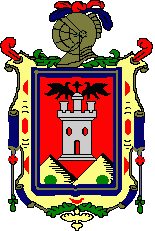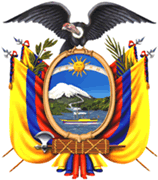Ecuador coat of arms
The Ecuador coat of arms, as described in a decree issued by the National Congress on November 7th, 1900, is as follows: An oval shield, containing the sun towards the top, in that section of the zodiac whose signs correspond to the months of March, April, May, and June. Below it, Mount Chimborazo, with a stream flowing from it to become a wide river. A steamboat on the river, with a caduceus forming the mast, symbol of navigation and of trade. The shield rests upon consular fasces, the insignia of republican dignity. The flags of the country stand at either side of the shield, together with wreaths of bay and palm leaves, and above it all stands the condor, with wings outstretched. The sun, as it follows the line of the Earth's equator, gives the country its name, and it was worshipped from the earliest times as a beneficent god. It is the highest symbol of an equatorial people.
The signs of the zodiac are those corresponding to the months in which the struggle for freedom was waged, culminating in the Battle of Pichincha, on May 24th, 1822. Mount Chimborazo symbolizes the Sierra, or inter-Andean region, while the wide river represents the coastal area. The river serves to unite the two regions, symbolizing that unity which has brought about the richness of the country, richness which in its turn is represented by the boat with a caduceus as a mast. The condor which crowns the shield represents power and liberty, invitolerant of restrictions.
Historical synthesis of the Coa: The Coa underwent six changes. The current graphical version, approved by the Ministerio de Instruccion Publica (Popular Education Office) in 1916 is a marvelous work of art due to the brushes of Pedro P. Traversari, which surpassed the many antiaesthetical graphical versions of the verbal descriptions contained in the 1845 and 1900 decrees.
These are the changes:
1) From 1821 the Free Province of Guayaquil used a white five-pointed star on blue field, surrounded by two laurel branches and the scroll "POR GUAYAQUIL INDEPENDIENTE".
2) While Ecuador was part of Greater Colombia, its arms were those in the 6th October 1821 Law decreed by the Cucuta Congress, ie. the cornucopies or 'horns of plenty', bound with a tricolour tape, and with the words 'Republica de Colombia' around it.
3) The 27th September 1830, the Constituent Congress meeting at Riobamba designed the arms of Ecuador thus: "the arms of Colombia will be used, a light blue field with a sun in the equinox over the phases and a scroll 'El Ecuador en Colombia'".
4) About 1836 and at least in 1846 a round Coa with two mountains and two doves carrying olive branches was used. On the sky, the sun amongst the signs of Leo, Scorpio, Balance and Virgo and seven stars over them. Beneath the mountains, a circular scroll 'Republica del Ecuador' surrounded by olive and laurel branches.
5) A decree was passed during the third mandate of General Flores, stating that "the [coat of] arms of the Republic will have a rectangular chief and a elliptical base. Its field will be divided into three quarters: the uppermost blue with the sun setting over a section of the Zodiac; the middle one divided into two, right a gold field with an open book with the Roman numerals I through IV indicating chapters of the Constitution, left a green field with a horse; the lowermost again divided into two, right a blue field with a river and a ship on it, left a silver field with a volcano. A condor with displayed wings on the top and flags and trophies at the sides.
6) The 1900 congress established the Coa as is known today, with the tricolour restored by Garcia Moreno in 1860, after the Jambeli victory where the Peruvian invaders sent by Castilla were expelled.


